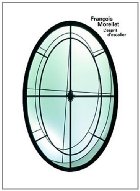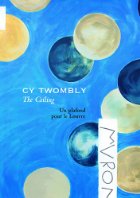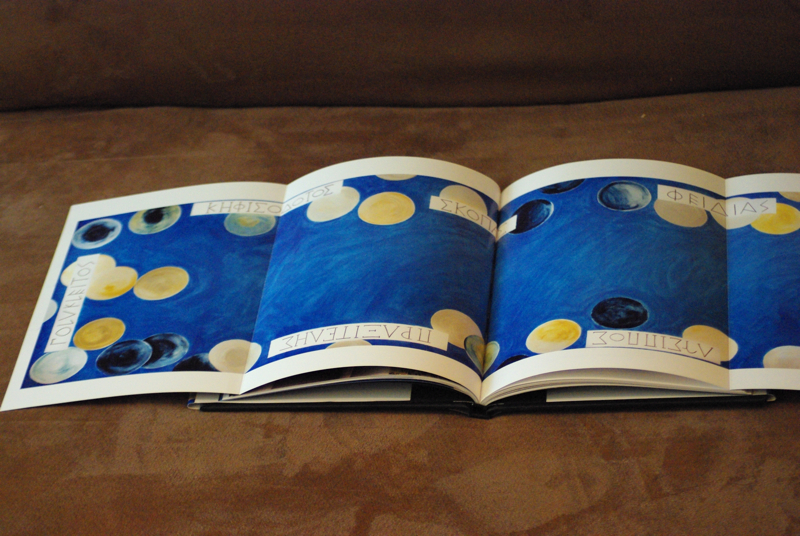

Today continues my series on a couple of the lovely Louvre-produced art books I picked up on my recent trip to France. As I wrote in my previous post on François Morellet's "L'esprit de l'escalier," both books are slim hardcovers edited by Louvre Contemporary Art Curator Marie-Laure Bernadac. Bernadac has included a helpful selection of supplementary material on each artist, including essays that speak to the place of each installation piece in the larger framework of the artist's oeuvre, and conducted interviews with both men about the conception and execution of their Louvre pieces. Today's book features Cy Twombly's ceiling mural, commissioned for the ceiling of the Salle des Bronzes Antiques. For some reason, possibly because Twombly is American, The Ceiling is presented as a bilingual English/French edition, whereas L'esprit de l'escalier is a French-only text. Since I stuck more or less to reading the English, and have a few extended quotes, I'll include them in Jennifer Kaku's "sanctioned" English translation only.
Cy Tombly: The Ceiling: Un plafond pour le Louvre
I think what first struck me about walking into the Salle des Bronzes Antiques and seeing Cy Tombly's ceiling there, was the seamless integration of the ancient with the thoroughly modern. No one would mistake Twombly's piece for anything but modern or contemporary, and yet it harmonizes so well, both with the Renaissance architecture of this room—in one of the oldest areas of the former palace—and the even older pieces being displayed in that room, which date from Greek and Roman antiquity. Indeed, in Twombly's interview with Marie-Laure Bernadac, he stresses that his primary aim in designing the ceiling was "to make something that was, above all, a response to this particular space," and that because of that, he approached the project differently than any of his other paintings: "I couldn't conceive of anything I did before as something that could be used for a ceiling." I wasn't familiar with Twombly's work before picking up this book, but after looking through a selection of his paintings I can see evidence of this different approach: even the mediterranean color scheme is a radical departure from his usual palette of greys, reds and beiges, and the calming, floating circles on a blue sky bear no obvious resemblance to his more famous style of all-over kinetic scrawls.
But one way in which the ceiling is of a piece with Twombly's oeuvre, is its integration of pieces of text into the visual whole, which is done in a way that stresses evocation, and imaginative work on the part of the viewer. He has many works that use a single name or poetic phrase—"Ovid," for example, or "Say Goodbye, Catullus, to the Shores of Asia Minor"—to evoke whole worlds of association in the mind of someone looking on. The ceiling works in a similar way, with the names of seven legendary Greek sculptors written around the edge of the piece in a style hinting at chiseled lettering. The relationship of Twombly's work with the art and literature of the past is one of the most intriguing aspects of it to me: other than the ceiling, I don't love his aesthetic, but I do enjoy thinking about the evocative power of names and literary fragments. Twombly himself, in a comment that reminds me of Faulkner, says
The past is a springboard for me. I get the impulse and excitement from the subject of the work. And then painting gives you a rush to do it in the way you do it. Anything interesting has a life of its own, like most aesthetic and creative things. Ancient things are new things. Everything lives in the moment, that's the only time it can live. But its influence can go on forever.
"Ancient things are new things": concisely and appealingly said. When we encounter some ages-old artifact that resonates with us, we're not seeing simply an object that was left behind centuries ago and ceased to interact with the world, but the repository of a whole set of histories that stretch from the date of its original construction (or, often, from before that) all the way up to our own times. And, in addition, we bring all our own associations to to object, and (to borrow from Wordsworth) those associations "half-create" the object we see. So that the name "Virgil," dropped into the void, conjures up images, not only of the Roman author of the Eclogues and the Aeneid, but also, depending on the hearer, the long history of European classical education, young boarding-school boys with book-straps and short pants, memorizing verses by rote and playing pranks on each other in chapel; and then possibly, for example, Virginia Woolf's novella Jacob's Room and the way in which its protagonists use Latinate words and Classical quotations to demonstrate their affection for each other, and Jacob's real-life model Thoby Stephen, the golden boy dead of typhoid at 26 while touring Greece, and so on and so forth. For someone else, the set of associations will be completely different. But If we don't bring our own associations or in some way imaginatively recreate the path from past to present, the object will likely not resonate with us at all and will seem a dry, lifeless lump of material. The ceiling uses this power of evocation to place seven legendary sculptors in the context of the Mediterranean modernism of the piece—but also in the context of the pieces on display in the Salle des Bronzes Antiques, which, as Richard Leeman points out in his essay on Twombly, does not actually contain any sculpture by the artists named:
And yet, quite paradoxically, this "room of the bronzes" does not contain any works by the sculptors referred to by Twombly, and the objects—rings, bracelets, fibulas, mirrors, vases, etc.—and sculptures that it does contain are, in fact, anonymous. Thus, between the names that embody, in Twombly's sky, the essence of sculpture and the very real objects and sculptures to which no name on earth is attached, there is a kind of optical illusion—which is in itself very Platonic. One of the reasons there are no works by the sculptors named by Twombly is that, in reality, very little remains of their sculptures. What we know about them comes either from copies or from literature: Description of Greece by Pausamias, for example, or Pliny the Elder's Natural History. This is precisely one of the effects of the "nominalist glory" that Barthes wrote about, once again, with regard to Twombly's names: language makes it possible to evoke what is not there or what is no longer there, and, in particular, famous works that exist only in name, in description, or in copy.
So interesting! By naming sculptors whose work is no longer extant, Twombly is exaggerating the phenomenon of evocation: there is no sculpture we moderns can look at, so the legends and associations are all that remain. In addition, though, the contrast between the named sculptors in the absence of the objects they made, and the displayed objects in the absence of named sculptors, creates such an appealing mirror image and brings the whole room together as a cohesive installation. I love that my first and final impressions of the work are similar to one another: raw gut reaction and intellectual analysis both stress the integration of the room as a work of art.



I was so sad to hear Cy Twombly had died. I saw his "Four Seasons" at the Tate Modern a few years ago and I could not stop looking at the pieces. Gorgeous. I love his work.
Oh, he talked a little bit about his Four Seasons in this book! He said that he saw a take on the Four Seasons theme by, I believe, Jasper Johns, and that all four of Johns's seasons looked to Twombly like winter. So he was like, "I'm going to do a Four Seasons that actually look like the seasons!" I haven't seen his take yet, though—at least not that I remember - I have been to (and loved) the Tate Modern.
I read The Aeneid in college, but when I hear "Virgil" my thoughts always go immediately to Dante.
The big theme I got from this post is the interplay between contemporary and historical. The former is made up of the latter, after all, as eras and events progress to the present. Very philosophical. I love your name for it, the "phenomenon of evocation."
Dante! Yes, of course, a whole other set of associations. And I love Twombly's assertion that "everything lives in the moment, that's the only time it can live." As you say, the past is rolled up into the present.
Don't remember ever seeing Twombly's work at the Louvre, but I love the tone of those ceiling blues! What fond memories of Paris you're bringing back to me--when I'm really fortunate, I sometimes dream of the last time I stayed in Paris on the Rue de Rivoli about equidistant from Notre Dame and the Louvre. Sheer bliss...
Isn't that a fantastic blue? Together with the pale yellow it's quite striking. I'm glad these entries are bringing back fond memories of Paris for you - they are for me and I barely got back. I must admit to still feeling a bit of post-trip let-down...it's lucky for me I bought so many books and I can revisit in spirit. :-)
I'm very intrigued by the use of language for evocation, or at least the process of naming, but I sort of wonder about it. What would the names evoke for the spectator who doesn't know who those artists are? What does the child see? Or someone who simply doesn't have that much art knowledge at their disposal? Words can be hugely evocative, I do agree. But is it necessary to know something about that which is evoked? I don't know Cy Twombly's work at all, so I have a free pass to ask the dumb question! :-)
Hmm, interesting question. I suppose it depends what you mean by "necessary." I think the more you know about the context of any work of art, the more you'll get out of it, so to get the MOST out of this one it's probably best to have some knowledge of ancient Greek art. But, for example, I can't read the Greek alphabet and I wasn't familiar with any of the seven sculptors named—and I reacted to the piece strongly enough on pure aesthetics (floating circles; rich, calming blue; pleasing color scheme; vaguely Mediterranean-looking) to want to buy a monograph about it. I'm assuming those are the levels on which a child or a person without art knowledge (me!) would relate to it. Then, when I learned more about the aesthetically pleasing yet (to me) indecipherable names, that was an extra bit of interesting knowledge.
But I also don't really have a problem with pieces of art that select for a certain audience. I don't subscribe to the idea that something MUST be accessible to everyone in order to be somehow valid, although I know that perceived elitism is a turnoff for many.
I can only imagine how amazing that ceiling was to see in person. It does look powerfully beautiful. I was thinking about your final point, the names with no art and the art with no names, before you said and considering how awesome that was. And how it also, despite the solidity of everything in the room, manages to convey a precarious fragility as well.
Yes! Fragility and a sort of zen feeling of just...being. It is one of the most well-integrated installation pieces I think I've ever seen. Glad you connected with the entry. :-)
Thank you for (as ever!)a wonderfully thoughtful reply to my question. I don't mind art that seeks a particular audience (I don't think there's any art that is really and truly available to everyone, whatever it may claim). I think I wondered more about whether you could respond to it wholeheartedly and profoundly, and you answered that for me with a yes!
Most definitely, it invites engagement! And yes, I agree that no art is truly available to everyone. A good argument for a wide diversity of art dispersed widely.